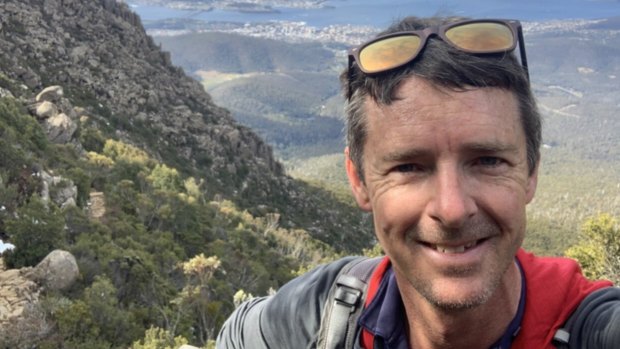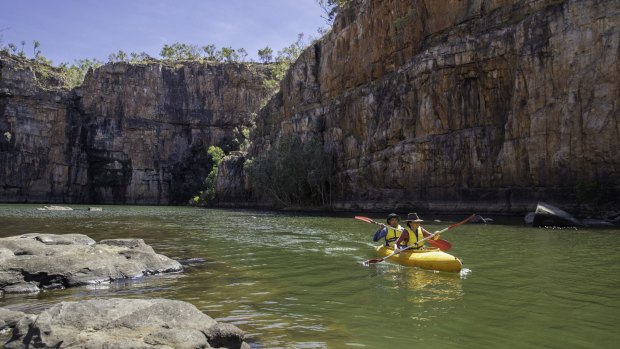This was published 1 year ago
The healing power of travel: I was a fit, adventurous traveller. Then I had a heart attack
By Andrew Bain

Travel writer Andrew Bain.
On an inland beach deep inside Nitmiluk (Katherine Gorge), night is falling fast. As I lie back in the sand outside my tent in the fleeting twilight, the cliffs momentarily flare with light before the sky fades into a mesh curtain of galaxies and stars.
We've paddled through the day to reach this remote campsite in the sixth of Nitmiluk's 13 interconnected gorges, dragging our canoe over long portages and gliding beneath the high cliffs that mark the southern edge of the Arnhem Land plateau. For much of the day, there hasn't been another person in sight.
I've spent so many nights in wild places like this one, but this evening there's a heightened sense of the magnificence of the place. I'm lucky to be here, which I mean in the most literal sense. I've long believed in the healing power of nature, and I've never needed it more than now.

Kayaking in Nitmiluk.Credit: Tourism NT
Less than four weeks before picking up this paddle, on a quiet Saturday morning at home, I suffered a significant heart attack. I'm far from your classic heart-attack victim: I'm 51, fit, my blood pressure is fine, my cholesterol is low, and there's no history of heart problems in my family. It was just a morning that had a random crack at killing me.
Twenty-seven days have passed since my heart attack as we take to the water from a pontoon in Nitmiluk's second gorge. Armadas of hired canoes set out twice a day from this spot, with most visitors paddling for a half-day or full day. Only by making an overnight trip, however, can you burrow deep into Nitmiluk, navigating as far up the ever-changing Katherine River as the ninth gorge. I'm here in search of solitude and strength, reminders from nature that I'm not broken.
Every one of the last 27 days has had at least a few moments of mild terror. My heart attack was so sudden and unexpected that it felt as though it could happen again at any time. Leaving hospital was the most vulnerable I'd ever felt. For days I flinched when people came near me, as though I now had something as fragile as a newborn chick inside my chest.
As our paddles first touch water inside Nitmiluk, the terror is magnified by the unknown. If I fail to cope with this paddling trip, and the taxing portages between gorges, is my life in the outdoors – such an indelible part of my self-identity for the last 25 years – all but over?
We paddle slowly through the second gorge, effectively test driving my own body as we glide along Nitmiluk's longest unbroken section of river. Patches of rainforest pour through breaks in the cliffs, and there are moments that I find myself forgetting the events of the last four weeks, absorbed instead in the spectacle of the gorge and the rhythm of the paddling.
I'd previously joked (well, half joked) to my partner, Ali, that I'd be treating the journey like a gondola ride, propelled lazily along by her efforts, but I'm quickly filled with confidence and the joy of movement through nature.
More and more scientific studies are taking note of the healing power of nature. A 2020 study by the European Centre for Environment and Human Health found that people who spend even two hours a week in nature are far more likely to report good health and mental wellbeing than those who don't.
Other studies have shown that time in nature can reduce blood pressure, boost cancer-fighting cells and improve mental health. Even opening a hospital window onto a natural scene has been shown to help patients recover after surgery.
It's scientific support for what humans have always seemed to know, even if often only at a subconscious level. Almost 2500 years ago, Hippocrates wrote that "nature itself is the best physician", while movements such as Japan's forest bathing are all about the medicinal value of nature. Masterful 19th-century American naturalist John Muir suggested that "everybody needs beauty as well as bread, places to play in and pray in, where nature may heal and give strength to body and soul alike".
I need both – strength for my body and soul – for it's my heart that has betrayed me, but it's the mental scars I've really come to heal. I need to again believe in myself and my ability to live as I choose and love.
With each gorge, and each portage between, belief begins to return. From gorge two into gorge three, there's a very short portage across a rock bar, but beyond here, the portages get longer and more strenuous, requiring us to drag 40 kilograms of boat and gear over rock slabs and awkward boulders.
At first, we move cautiously, carrying the canoe a few metres and then pausing to slow my heart rate and catch my breath. But as my body signals its comfort in the surrounds and the level of activity, I begin to haul the canoe behind me like a sled, moving joyously, if laboriously, between gorges. Normally I might resent the effort and tedium of these rocky intrusions, but today they only remind me of the pleasure of being alive.
The longest of these portages separates gorge three from four, where we drag our canoe over 800 metres of boulders and rock slabs, taking almost an hour to reach water again. But as we begin paddling through gorge four, we're entering rare territory.
Most day canoeists don't make it this far up the gorge, discouraged by the tough portage. But it's here that Nitmiluk comes into its own, with the cliffs closing in and Smitt Rock, a massive anvil of red rock, standing like a sentinel in the middle of the gorge.
At Smitt Rock's end is the first of Nitmiluk's canoe-only campsites, settled softly into a beach. But after a swim, we paddle on, entering the long, straight tunnel that is gorge five. In here, Nitmiluk is a deep cut chiselled into the outback. I can see the edges of the world above – a dry and unforgiving place, blurred with heat and spinifex, in contrast to this gorge air-conditioned by breezes and swims.
A trio of boulder-strewn portages make the transition into gorge six another difficult one, and my beat-up body is starting to fatigue, but our campsite is now just metres ahead.
We briefly paddle past the camp, heading further upstream to explore gorge seven, where the narrow gorge widens and opens into a shallower depression.
The campsite in gorge six is squeezed between cliffs and elevated atop a dune-like beach. We pitch our tent in the sand and watch the afternoon's hurried march towards evening. There is nobody else about – it's just us and a nesting peregrine falcon in the cliffs immediately across the river, intermittently soaring past like a tiny fighter jet.
These cliffs dominate our view, and they're as impressive as any through the gorge. Tall sand palms cling precariously to narrow ledges and faint cracks, and the stained rock walls resemble an enormous Aboriginal rock art site.
As night falls, and stars begin to spill across the sky, I recall hearing a scientist once suggest that the bulk of the world's population has never seen the Milky Way, with more than 80 per cent of the Earth's land surface now covered in enough light pollution to wipe the galaxy from view.
More than my heart attack, that sort of removal from the natural world feels like our true sickness. As I lie back in the Nitmiluk sand, I am indeed one of the lucky ones. I'm filled with wonder: for this extraordinary gorge, for this dusted sky, for the fact that I'm still here at all.
I can't remember the last time I felt this physically tired, and the entire day feels surreal, but for the first time since I was rushed to hospital, ambulance sirens blazing, I feel as though life is ready to begin again.
See also: 'No way are we going to hide': Lonely Planet founder's year of travel
See also: Wellness retreats are very good at making you feel bad
Sign up for the Traveller Deals newsletter
Get exclusive travel deals delivered straight to your inbox. Sign up now.